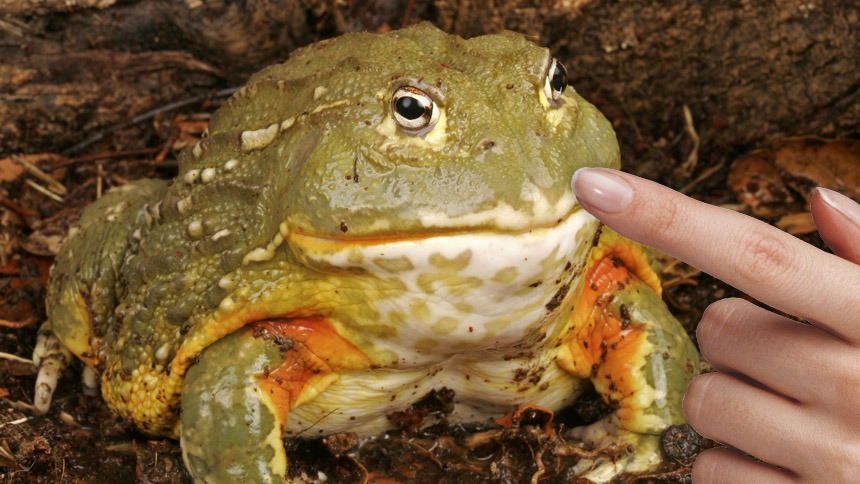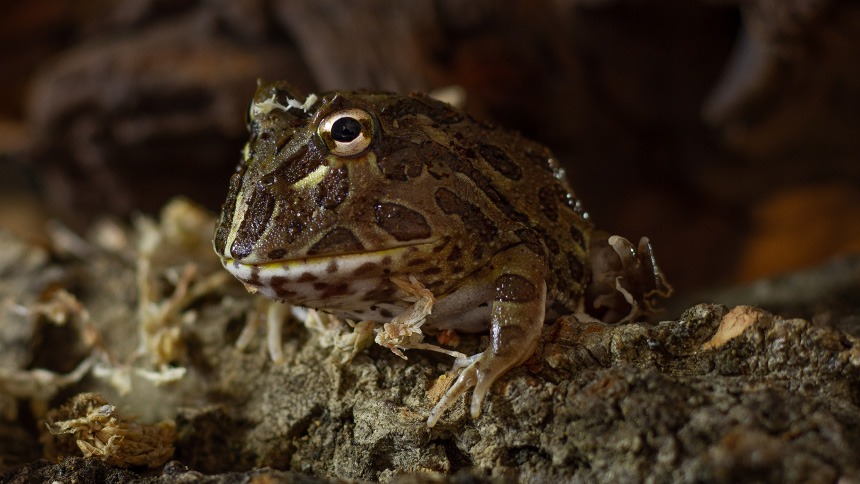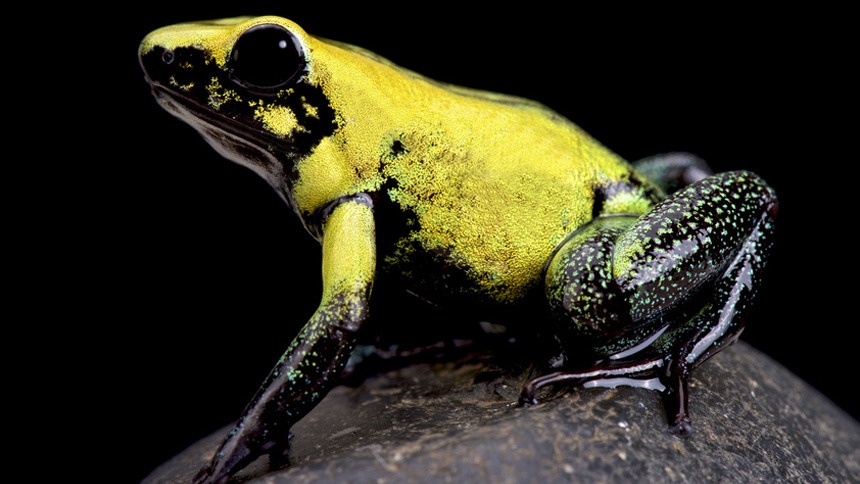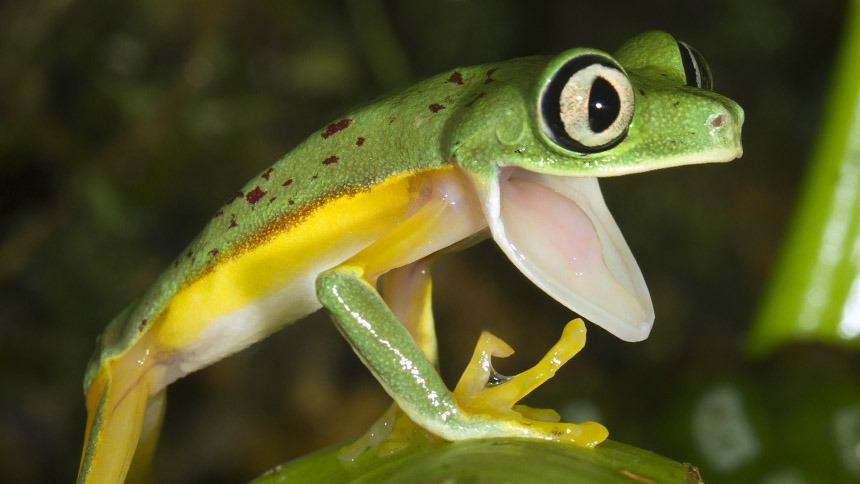
Do Frogs Bite?
People love frogs because they’re exotic, fascinating, exciting, and relatively simple to care for. Knowing these things about them makes it easy to see why so many people keep them.
The fact that frogs are common throughout the world means that people interact with them often. Frogs have mouths, and they use them when necessary.
Hobbyists (myself included) keep frogs as pets. And, unfortunately, they (sometimes) bite. So… how should you deal with it, and does it hurt? What kind of frog bites? Find out in this article. We will also discuss some poisonous frogs you should avoid.
Page Contents
Do Frogs Really Bite?
Yes! Frogs do bite (occasionally). Human interaction does not appeal to them. In fact, they prefer to avoid interactions with any creature bigger than them.
However, humans and frogs happen to interact with each other, and these interactions sometimes end up with a frog bite. Individuals who have pet frogs mostly become the victims of frog bites.
Frogs are not ungrateful pets, and they do not bite the owners out of any malicious intention. Mostly, frog bites happen when the owners try to feed their pets with their hands.
Therefore, you may get bitten by a frog when you are feeding it and your finger gets too close. Some species are worse than other about biting.
So, frogs mostly bite when they feel threatened or think of something as their food. The majority of frogs do not enjoy human interaction. Thus, when they see a human or human hand coming at them, they will run away or hide.
Why Frogs Bite & What To Do If You Get Bit
Now you know that frogs bite when they feel threatened, or they mistake something for their food. Pacman frogs are among the species of frogs that bite as an act of defense to protect themselves from predators.
They attack the prey with a powerful jaw and tiny teeth (used mostly for keeping food in their mouth). So, be careful while dealing with your pet Pacman frogs or suddenly interacting with them in the wild.
A bite from a Pacman frog is formidable (for their size), but you probably won’t have to rush to the local emergency room. It’s unlikely to bleed or swell. It’s more of a shock than anything.
So, how do you react when you’re bitten? What are the measures to take in cases of a frog bite? It’s true that frogs don’t possess razor-sharp teeth. So, when they are trying to bite you, just give them a few moments to let go. Vigorous shaking is a big NO in such scenarios.
It’s hard to imagine a frog could even break your skin. Calm down and gently remove your finger.
I remember the first time my son’s juvenile Pacman frog bit me. It didn’t hurt. I was startled. Slightly offended, truth be told. Here I was gently placing feeder crickets in his enclosure and BAM! He got me.
He released shortly after biting, which is typical. There are cases, however, of frogs biting and holding on to fingers for extended periods of time. Should this happen to you, gently use your other fingers to push its mouth off of your finger. Be mindful that you’re near the ground so when the frog releases, he won’t fall far.

Popular Pet Frogs Known for Biting
The answer is yes. Several species of frogs actually enjoy the sensation of biting, even though most frogs don’t. African Bullfrogs, Pacman Frogs, and Budgett’s Frogs are among them.
- Pacman Frogs do not mind biting anything that appears to be threatening to them. They have a strong jaw and formidable bite for their size. Many individuals who have Pacman Frogs ask questions regarding the perfect method of feeding them. The process is simple. You just need to use a tong to feed them.
- Budgett’s Frogs enjoy attacking predators and any potential threat. When they perceive that you are a threat, they will try to frighten you by making them appear big and creating noise. If you are witnessing any of the signs made by a Budgett’s Frog near you, it is time to distance yourself. Otherwise, you may end up getting bitten.
- African Bullfrogs as popular pets among the herptile community. However, even they are known to bite. They use their big jaws and teeth to bite and hold prey.
What about poisonous frogs
The poison dart frog is so deadly that native hunters once used them to make poison darts. What makes these beautiful animals so dangerous?
Among the Colombian rainforest’s humidity, a hunter makes his way between the trees in search of food. Having spotted a monkey, the hunter steadies his blowgun, dart in-place and ready to fire. A single dart is all it takes.
A first-hand account from 1825 describes the dart as, “sure death to any man or animal it strikes.” Its poison makes it deadly for humans and animals alike.
Hunters from Columbia’s Embera tribe frequently used poison darts to kill birds, monkeys, and other small animals, made from the poison of small yellow frogs only a few centimeters in length.
Golden Poison Frogs are among the deadliest animals on the Earth and carry enough toxin to be lethal to 10 grown men. Despite their small size, they can be very dangerous: the largest is no more than 6 cm, while some are no longer than 1.5 cm. How did they become so poisonous, and why?

It is true that many different species of animals produce toxins, but most are not harmful to humans. To be poisonous, an animal must excrete toxins. Those toxins are considered poison because they’re a harmful substance that is ingested or absorbed.
For instance, lethal snakes such as the Rattlesnake are technically not poisonous – they’re venomous. Venom is a harmful substance that is injected via fangs, stingers, etc.
But are there venomous amphibians? And if so, is harmful toxin delivered via their teeth (biting)?
Are there venomous amphibians?
The majority of frogs, as well as salamanders and newts, secrete toxins. They use these poisons to defend themselves against predators, so swallowing them is dangerous.
However, the authors of a 2015 study suggested that there may be some amphibians that, if studied more closely, could actually be venomous.
Moreover, the authors suggest that other frogs with spines in their heads could be studied to determine if they are venomous, as well. Corythomantis greening and Aparasphenodon brunoi are among the species studied.
Therefore, there may be other venomous amphibians yet to be formally identified, even though they are uncommon.
To summarize the poison section: Most frogs are at least mildly toxic, making them “poisonous”. Nearly all of them are harmless to humans aside from a small group of poison-dart frogs in the Phyllobates genus (they’re potentially deadly). Moreover, there are a few venomous frogs but, so far as we know, the toxins aren’t delivered via teeth or biting!
For more information on this topic, check out how to tell if a frog is poisonous.
Frequently Asked Questions
Listed below are some of the most common questions I’ve seen around the internet. If you’ve got a question, feel free to ask in the comment section below.
Are Garden Frogs Dangerous?
Frogs in the garden can be beneficial since they eat pests. However, their vocalization and egg-laying in swimming pools cause clogs in the skimmers and filters, as well as a nuisance. The presence of frogs in the garden can also pose health risks to pets and humans.
An infection can occur from contact with frogs because they may carry salmonella bacteria. Salmonellosis, a bacterial infection, may cause diarrhea, fever, and abdominal pain. Salmonella is especially harmful to children under five years of age and to people with weak immune systems.
Reptiles, such as snakes, lizards, and turtles, and other amphibians, such as salamanders, can also transmit salmonella. If you touch a frog, you should wash your hands with soap and water.
Additionally, be careful not to swallow any frog toxin before you wash your hands as it may cause illness. When young children play in the garden, you should warn them not to touch any frogs and supervise them closely.
Other than that, having toads and frogs in your garden is considered a good thing (by most).
Are Frog Bites Poisonous?
There are many poisonous frog species. The Poison Dart frogs are surely leading the chart. As we have already mentioned, the native hunters used to make deadly weapons using these frogs.

You should, however, remember that there is a significant difference between venomous animals and poisonous animals.
Please make a note that poisonous creatures do not transfer any poison through their bites.
However, some venomous frogs with spiny heads exist on the Earth, and they are harmful. They, like other venomous animals, use a piercing mechanism to deliver their toxin.
My point is that, despite the fact that many frog species are poisonous, they cannot transfer the poison to the ones through their bites. At least not that we know of.
Therefore, answering your question, we can say that in most cases frog bites are not poisonous. However, you should try to maintain minimum interactions with them to avoid any unpleasant experience.
Do poisonous frogs bite?
The answer is yes. However, as mentioned before, they are not venomous. You will only be affected by their poisons if you come into contact with or ingest their toxins.
If you keep a frog, then you should make sure that it is not feeling scared or threatened. Feeding frogs with tongs is a good practice to avoid bites during feeding time.
Is it okay to hold a wild frog?
Frogs dislike human interaction. To them, humans are giants and not to be trusted. Due to this, handling a frog almost always results in causing unwanted stress for them.
Not only that but amphibians have semi-permeable skin. This means they easily absorb that which comes into contact with their skin. Any chemical residue lingering on your hands can be absorbed into the frog.
The whole interaction of handling frogs usually results in the frog being injured – not you (even if it bites you). I always discourage people from handling wild frogs due to this.
However, if you simply cannot help yourself, there are some safety precautions that will help ensure your safety as well as the safety of the frog. You can learn more by reading this post about proper frog handling etiquette.
Conclusion
Keeping frogs as pets is a fascinating experience. Generally, they are very nice and innocent creatures. Understandably, they can feel threatened at times and lash out. Some species are worse about it than others. Frog bites can occur when you are trying to feed them with your hands.

Leave a Reply